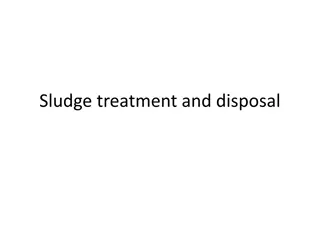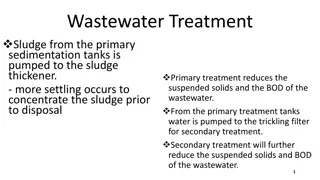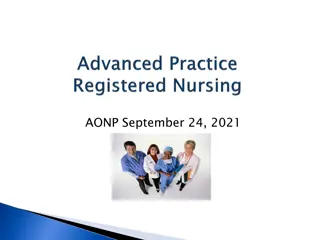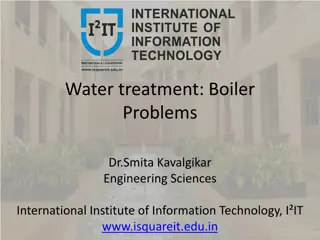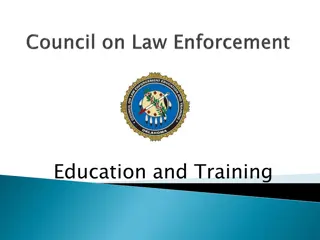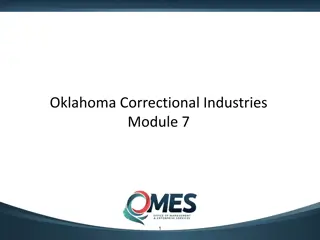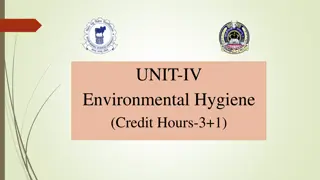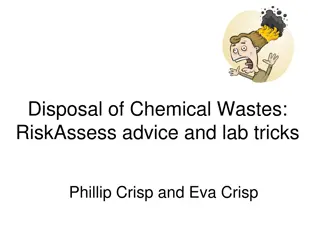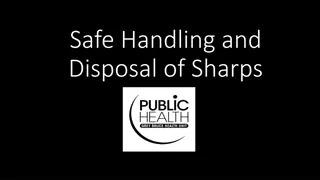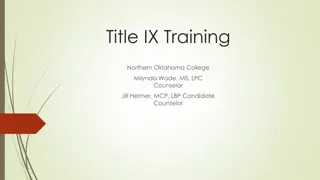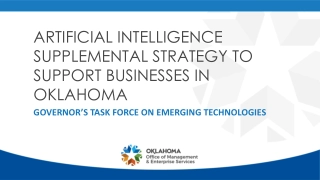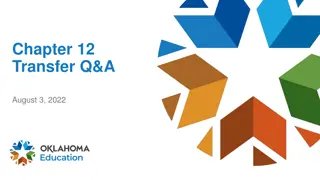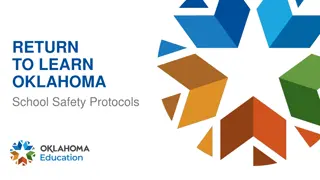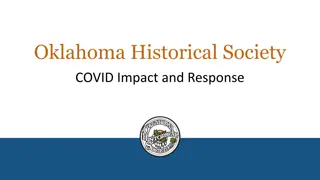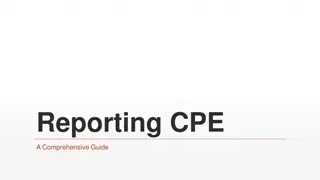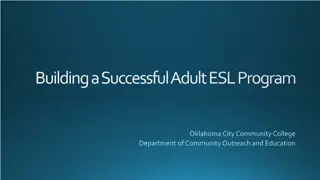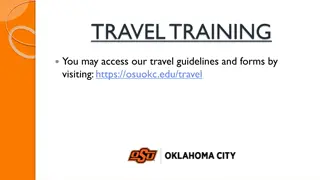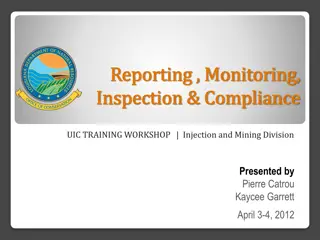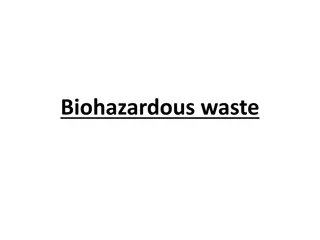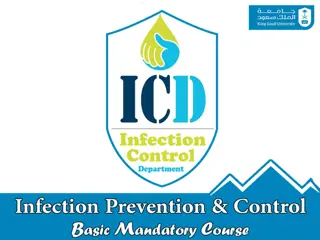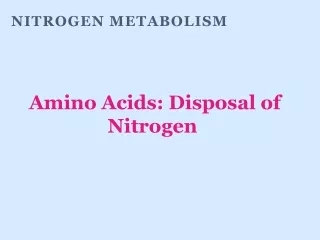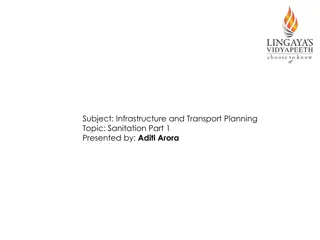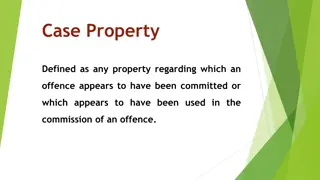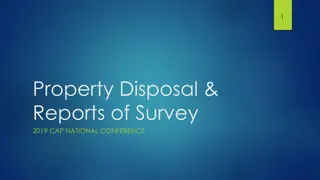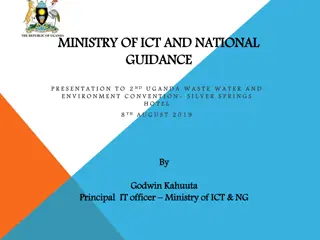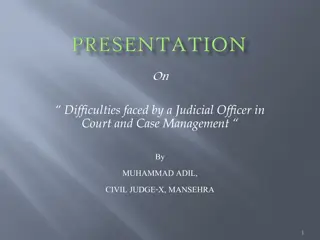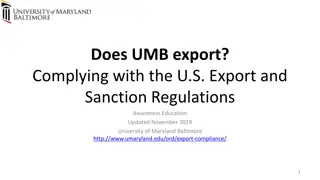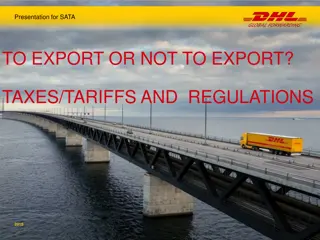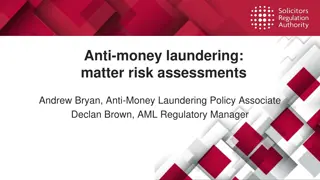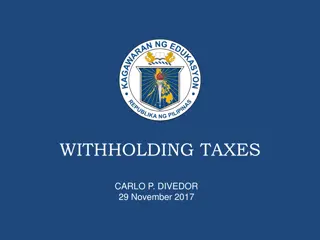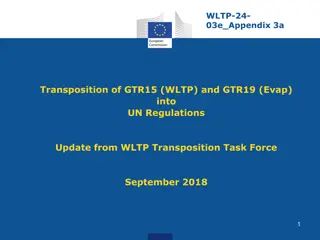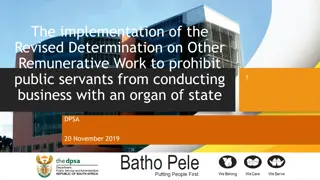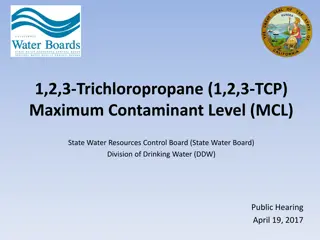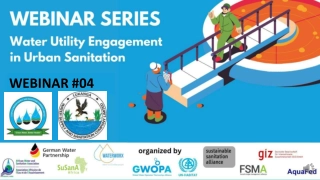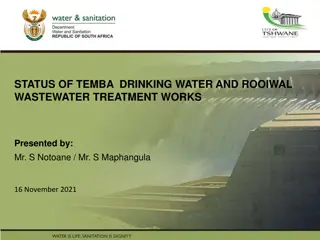Understanding Sludge Disposal Regulations in Oklahoma
Major facilities in Oklahoma must adhere to specific regulations when disposing of sludge, with two primary methods of disposal: Landfill and Land Applied. EDMRs must be submitted annually by February 19th, covering the previous year. Testing requirements include Toxicity Characteristic Leaching Procedure (TCLP) within the first 12 months of a new permit. Land application of sludge involves stringent requirements such as information transfer, pollutant tracking, and restrictions on mixing EQ and non-EQ sludge to maintain quality standards.
Download Presentation

Please find below an Image/Link to download the presentation.
The content on the website is provided AS IS for your information and personal use only. It may not be sold, licensed, or shared on other websites without obtaining consent from the author. Download presentation by click this link. If you encounter any issues during the download, it is possible that the publisher has removed the file from their server.
E N D
Presentation Transcript
The dirty word..SLUDGE Only Major facilities have to send in eDMRs for sludge Two different ways in Oklahoma to dispose of sludge: Landfill and Land Applied. Each have different parameters to test for before sludge is disposed. The sludge eDMRs shall be due by February 19th of each year and shall cover the previous January through December time period. Four eDMRs have to be filled out: SLDP (Production and use), SLDF (Landfill), SLLA(Land Applied), SLSA(Surface disposal) Each permit cycle, the facility has to test for Toxicity Characteristic Leaching Procedure (TCLP) within the first 12 months of the effective date of the new permit. If you do not test within the 12 months, it is a violation. If you fail the TCLP, you must notify DEQ Waste Management within 7 days after failing the TCLP.
General requirements of land application of sludge Transfer of sufficient information among the preparer, land applier, landowner, and permitting authority Tracking of the cumulative pollutant loading from sludge that is non-EQ for pollutant concentrations Movement of sludge across state lines
What determines the quality of the sludge? 3 Parameters for determining sludge quality: Pollutants (PC limits) Arsenic, cadmium, copper etc.. Pathogen Reduction Bacteria, viruses, and parasites Attractiveness to vectors Rodents, flies, and mosquitos If all three are met the sludge is considered Exceptional Quality (EQ). EQ has no requirements except don t mix with non-EQ sludge.
Terms to know for land application of sludge Pollutant concentrations (Table 3)-Is one of three levels to determine the quality of the sludge. Ceiling concentrations (Table 1)-Is the maximum concentration of pollutants on a eDMR Cumulative Pollutant Loading Rates- CPLR- (Table 2)-Is the maximum amount of pollutant that can be applied to an area of land. Applies to bulk sludge that is applied. Annual Pollutant Loading Rates- APLR-(Table 4)-Is the maximum amount of sludge applied to an area during 365-day period. Applies to sludge sold in bag or other containers Annual whole sludge application rate-AWSAR- Maximum amount of sludge on dry weight basis during 365-day period. Pathogen Reduction-Is the presence or absence of pathogens (disease causing organisms). Two classes of pathogen reduction: Class A is pathogen free sludge after treatment and Class B is reduced pathogen but not eliminated pathogens. Vector Attraction Reduction-Animals or insects that are attracted to sludge that could transmit pathogenic organisms to humans.
Pathogen Reduction Two classes of pathogen reduction: Class A and Class B Class A is virtually free of pathogens levels. Has no site restrictions. Class B has reduced pathogens levels. It has site restrictions to allow for natural processes to further reduce pathogen levels. Class A has 6 alternatives to reduce pathogen levels. Class B has 3 alternatives to reduce pathogen levels. Class B- Alt# 1: Seven separate random samples representative of the sewage sludge shall be collected for one monitoring episode at the time the sewage sludge is used or disposed. The geometric mean of the density of fecal coliform in the samples collected shall be less than either 2,000,000 MPN per gram of total solids (dry weight basis) or 2,000,000 Colony Forming Units per gram of total solids (dry weight basis). Most commonly used Class B- Alt# 2: Sewage sludge shall be treated in one of the Processes to Significantly Reduce Pathogens (PSRP) described in 40 CFR 503 Appendix B. Class B- Alt# 3: Sewage sludge shall be treated in a process that is equivalent to a PSRP, if individually approved by the Pathogen.
Vector Attraction Reduction There are 10 options to reduce attraction. The most common reductions are the following in Oklahoma: Option 9- Sludge is injected below the surface of the land. No significant amount of sludge shall be present on the land surface within 1 hour after injection. Option 10- Sludge is incorporated into the soil within 6 hours after application to the land. Both options have class A sludge requirements. The sludge has to be incorporated within 8 hours after pathogen treatment process to prevent regrowth of bacteria.
How to fill out the eDMR when you land apply the sludge Four eDMRs have to be sent in: SLDP, SLDF, SLLA, SLSA But only two need to have data: SLDP and SLLA The other two SLDF and SLSA are NO DISCHARGE
How to fill out the eDMR when you land apply the sludge continued Start out with the production and use eDMR. What needs to be filled out: PCB s-Testing requirement is once/year. Do not report 0 if the sample is below practical quantification limit. Instead use < of the highest value below detectable limit. Toxicity characteristic leaching procedure-Testing requirement is once/ permit life cycle. This test should be done within one year from the effective date of the permit. If the sludge has passed the test, the form must be indicated with a 0" (Pass). If the sludge does not pass the test, the form must be indicated with a 1" (Fail). This parameter may be reported as *9 (Not Applicable) if sludge is not applied to facility during the monitoring period. Total annual sludge production-Facilities must indicate the amount of sewage sludge produced after final sludge treatment for the reporting period. Annual amount of sludge land applied must be reported.
Production and use eDMR (SLDP) Use *9 if test was not done during calendar year. Due within 12 months of the effective date of permit If sample was BPQL don t use zero. Use the highest of pollutant value and use the less than sign. Enter zero Amount produced after treatment during calendar year Enter zero Amount land applied during calendar year Enter zero Enter zero if no sludge was landfilled Enter zero if no sludge was transported
Land Application DMR (SLLA) Table 2- CPLR- Report 0 if under the PC limit Table 1- Ceiling concentration- If exceed can t land apply Table 3- Pollutant concentrations AWSAR-Is 0 in Oklahoma
Land Application DMR (SLLA) If PC limit is met = 3. If PC limit is exceeded= 2. APLR (4) is only used if sludge is sold in bag or other container If sludge is pathogen free= Class A. If sludge is not free of pathogen= Class B How the sludge was treated to meet pathogen requirements. Class A has 6 alternatives and Class B has 3 Vector Attraction Reduction have two options (9 or 10)
What determines a violation for land application of sludge DMR The PC limit only helps in determining the quality of sludge. It is not a violation. Exceeding the ceiling concentration. The facility can t land apply sludge if it exceeds the ceiling concentrations (Table 1). Must dispose by of other method (Landfill). If the facility does land apply, it s an automatic Notice of Violation. The facility can t exceed the CPLR. The facility must find a new site to land apply. Non-submit of sludge eDMRs. Not submitting Certification Statements along with eDMR
Certification Statement and Recordkeeping for Land Applied Sludge Records must be keep for 5 years and sent to DEQ. Certification Statements must be submitted to DEQ with the eDMR for both Class A or Class B Certification Statement for: 1) Pollutant limits 2) Vector Attraction Reduction 3) Pathogen Reduction 4) Management Practices
Certification Statement for Pollutants Limits I certify, under penalty of law, that the requirements to obtain information in 503.12(e)((2) ____________________[insert either have been met or not been meet] for each site on which bulk sewage sludge is applied. This determination has been made under my direction and supervision in accordance with the system designed to ensure that qualified personnel properly gather and evaluate the information used to determine that the requirement to obtain information have been met. I am aware that there are significant penalties for false certification including fine and imprisonment _____________________________________________________________________ Name Date Telephone#
Certification statement for Pathogens Reduction I certify, under penalty of law, that the site restrictions in 503.32(b)((5) ____________________[insert either have been met or not been meet]. This determination has been made under my direction and supervision in accordance with the system designed to ensure that qualified personnel properly gather and evaluate the information used to determine that the site restrictions have been met. I am aware that there are significant penalties for false certification including fine and imprisonment _____________________________________________________________________ Name Date Telephone#
Certification statement for Vector Attraction Reduction I certify, under penalty of law, that the vector attraction reduction requirement in ___________ [either 503.33(b)(10) or 503.33(b)(10)] _________[insert either has been met or has not been met]. This determination has been made under my direction and supervision in accordance with the system designed to ensure that qualified personnel properly gather and evaluate the information used to determine that the vector attraction reduction requirement have been met. I am aware that there are significant penalties for false certification including fine and imprisonment _____________________________________________________________________ Name Date Telephone#
Certification statement for Management Practices I certify, under penalty of law, that the management practices in 503.14 ______________[insert either has been met or has not been met] for each site on which bulk sewage sludge is applied. This determination has been made under my direction and supervision in accordance with the system designed to ensure that qualified personnel properly gather and evaluate the information used to determine that the management practices have been met. I am aware that there are significant penalties for false certification including fine and imprisonment _____________________________________________________________________ Name Date Telephone#
Class A Certification Statement The following certification statement: I certify, under penalty of law, that the information that will be used to determine compliance with the Class A pathogen requirements in 503.32(a) and the vector attraction reduction requirement in [insert one of the vector attraction reduction requirements in 503.33(b)(1) through 503.33(b)(8)] was prepared under my direction and supervision in accordance with the system designed to ensure that qualified personnel properly gather and evaluate this information. I am aware that there are significant penalties for false certification including the possibility of fine and imprisonment. _____________________________________________________________________ Name Date Telephone#
Class A Certification Recordkeeping (1) The concentration of each pollutant listed in Table 3 of 503.13 in the sewage sludge. (2) A description of how the Class A pathogen requirements in 503.32(a) are met. (3) A description of how one of the vector attraction reduction requirements in 503.33 (b)(1) through (b)(8) is met.
Certification statement where sludge that is Class B for Pathogens is applied I certify, under penalty of law, that the ___________ [insert either landowner or lease holder] has been provided with notice and necessary information regarding the requirement to implement the site restrictions in 503.32(b)((5). This notification has been made under my direction and supervision in accordance with the system designed to ensure that qualified personnel properly gather and evaluate the information used to determine that the site restrictions have been met. I am aware that there are significant penalties for false certification including fine and imprisonment _____________________________________________________________________ Name Date Telephone#
Requirements for Landfill Sewage sludge shall be tested as needed, or at a minimum, once/year in accordance with the method 9095 (Paint Filter Liquids Test) as described in "Test Methods for Evaluating Solid Wastes, Physical/Chemical Methods" (EPA Pub. No. SW-846). The permittee shall develop the following information and shall retain the information for five years. a. The description, including procedures followed, and results of the Paint Filter Tests performed. b. The description, including procedures followed, and results of the TCLP Test. Reporting requirements - The permittee shall report annually on the Discharge Monitoring Report the following information: a. Results of the Toxicity Characteristic Leaching Procedure Test conducted on the sludge to be disposed (Pass/Fail). b. Annual sludge production in dry metric tons/year. c. Amount of sludge disposed in a municipal solid waste landfill in dry metric tons/year. d. Amount of sludge transported interstate in dry metric tons/year. A certification that sewage sludge meets the requirements in 40 CFR Part 258 concerning the quality of the sludge disposed in a municipal solid waste landfill unit shall be attached to the DMR.
How to fill out the eDMR when you landfill the sludge Four eDMRs have to be sent in: SLDP, SLDF, SLLA, SLSA But only two need to have data: SLDP and SLDF The other two SLLA and SLSA are NO DISCHARGE
Production and use eDMR (SLDP) Use *9 if test was not done during calendar year Report if the landfill requires PCB to be tested. If not use *9 Enter zero Amount produced after treatment during calendar year Enter zero Enter zero Enter zero Amount of sludge that was landfilled Enter zero if no sludge was transported
Landfill eDMR (SLDF) Paint filter test- Pass is 1 and Failed is 0
Testing Requirements 1. Sewage sludge shall be tested once during the life of the permit within one year from the effective date of the permit in accordance with the method specified at 40 CFR Part 268, Appendix I [Toxicity Characteristic Leaching Procedure (TCLP)] or other approved methods. Sludge shall be tested after final treatment prior to leaving the publicly owned treatment works (POTW) site. Sewage sludge determined to be a hazardous waste in accordance with 40 CFR Part 261, shall be handled according to Resource Conservation and Recovery Act (RCRA) standards for the disposal of hazardous waste in accordance with 40 CFR Part 262. The disposal of sewage sludge determined to be a hazardous waste, in other than a certified hazardous waste disposal facility shall be prohibited. The DEQ, Waste Management Division at 405-702-5100, shall be notified of test failure within 24 hours. A written report shall be provided to this division within 7 days after failing the TCLP. The report will contain test results, certification that unauthorized disposal has not occurred and a summary of alternative disposal plans that comply with RCRA standards for the disposal of hazardous waste. The report shall be addressed to the Director, Waste Management Division, DEQ, 707 N. Robinson, Oklahoma City, Oklahoma 73101-1677 and a copy sent to the Director, Water Quality Division, DEQ, at the same address.
Recordkeeping Requirements The permittee shall develop the following information and shall retain the information for five years: The sludge documents will be retained on site at the same location as other OPDES records. A certification statement that all applicable requirements (specifically listed) have been met, and that the permittee understands that there are significant penalties for false certification including fine and imprisonment. See 40 CFR 503.17(a)(1)(ii) or 40 CFR 503.17(a)(3)(i)(B), and OAC 252:648 whichever applies to the permittees sludge treatment activities. The certification statement listed in 40 CFR 503.17(a)(1)(ii) or 40 CFR 503.17(a)(3)(i)(B), and OAC 252:648 whichever applies to the permittees sludge treatment activities, shall be attached to the DMR.


